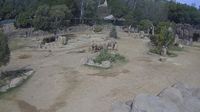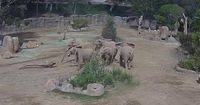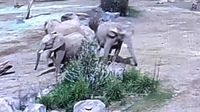Elephants at the San Diego Zoo Safari Park took swift action during a 5.2-magnitude earthquake that struck Southern California on April 14, 2025. As the ground shook, the herd instinctively formed a protective circle around their young, showcasing their remarkable social behavior and intelligence.
Video footage captured the moment when the five African elephants—Ndlula, Umngani, Khosi, and their two 7-year-old calves, Zuli and Mkhaya—reacted to the tremors. Initially standing calmly in the sun, the elephants quickly scattered as the earthquake hit, but the older females soon regrouped to encircle the calves. They remained huddled together for several minutes, with the adults facing outward, ready to defend against any perceived threats.
The earthquake, which was felt from San Diego to Los Angeles—approximately 120 miles away—was part of a series of seismic events that included a 3.3-magnitude quake the day prior, near Julian, California. While the earthquake sent boulders tumbling onto rural roads and knocked items off store shelves in nearby towns, it resulted in no reported injuries or significant damage.
Mindy Albright, a curator of mammals at the San Diego Zoo Safari Park, explained the behavior of the elephants during the quake. "When they perceive a threat, they often bunch together in an 'alert circle,' typically with the young clustered in the center and the adults facing outward to defend the group," she said. This instinctive behavior highlights the elephants' intelligence and strong social bonds, which are vital for their survival.
In the video, one of the calves, Mkhaya, can be seen seeking refuge between the adults, while Zuli, the only male calf, positioned himself on the edge of the circle, displaying a desire to show courage and independence. Khosi, a teenager who helped raise him alongside his biological mother, Ndlula, was observed gently tapping him with her trunk, as if to reassure him that everything was okay and to encourage him to stay back in the safety of the circle.
Albright noted that while Zuli is still very much a baby and is treated as such, his role will evolve over the coming years. As he matures into a bull, he will eventually join a bachelor group, while the female elephants typically remain with their family units for life. "It's so great to see them doing the thing we all should be doing—that any parent does, which is protect their children," Albright remarked.
Approximately an hour after the initial quake, an aftershock occurred, prompting the elephants to huddle together once more before dispersing again as they assessed their surroundings and confirmed that everyone was safe.
The San Diego Zoo Safari Park, home to eight African elephants, spans six acres and features two main yards where the elephants live. The park offers enthusiasts the opportunity to watch a live feed of the elephants, allowing visitors to observe their daily behaviors and interactions.
California Governor Gavin Newsom was briefed following the earthquake, and his office confirmed that the state was coordinating with local authorities to assess any damage and determine if emergency response efforts were necessary. Fortunately, the earthquake's impact on the surrounding communities was minimal, although it served as a reminder of the seismic activity that frequently occurs in the region.
The elephants' protective behavior during the quake has garnered attention and admiration from animal lovers and experts alike, demonstrating not only their instinctual reactions but also the deep familial bonds they share. As the footage circulates online, many are left in awe of the elephants' ability to respond to danger and protect their young in a moment of crisis.
In a world where human and animal interactions are often highlighted through various narratives, this incident at the San Diego Zoo Safari Park serves as a poignant reminder of the intelligence and emotional depth of elephants. Their actions during the earthquake reflect a universal instinct among parents—both human and animal—to safeguard their young, reinforcing the importance of family and community in the face of adversity.









